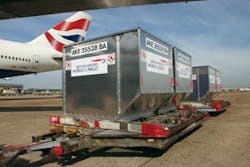Air freight growth is sluggish. IATA figures for the first six months of 2007 show just a 2.7 percent increase, well below what was a relatively slow 2006 at 4.6 percent. Although May and June rates (up 5 percent and 4.9 percent respectively) suggest better times ahead, demand is not what it could be.
Perhaps it is just as well. Slow growth may never be a good thing but with cargo infrastructure problems at many major airports, air freight’s inefficiencies would only receive greater exposure. The challenge for handlers is to work around these obstacles and yet still deliver a quality service.
Stephan Beerli of Swissport, the largest independent cargo handler in the world, reports that in many instances the cargo infrastructure available simply does not meet market needs. He says many airports focus most of their resources on the passenger side and too often cargo warehouses, ramp spaces and roads to/from cargo areas take a back seat. “They do not get included in the initial plans and thus are not organized as efficiently,”
he says.
Lack of warehouse space is perhaps the biggest bugbear right now. “During the peak seasons warehouses can become chaotic, particularly at the higher demand cargo airports and, as more and more capacity is deployed, this becomes an increasing problem,” agrees Baba Devani, vice president, sales and international customer service, BA World Cargo.
Of course, this assumes the aircraft can land in the first place — by no means a guarantee when slots are also at a premium. Devani confirms that in markets that suffer a peak, such as Shanghai, securing the right slots can be a real challenge.
Such infrastructure deficiencies can be best highlighted by perishables. Transporting them is a complex process requiring on-time arrivals and departures, the close proximity of aircraft parking relative to the cargo facilities as well as the necessary equipment. Only then can “cool chain” integrity be maintained throughout the end-to-end process. Too often, however, there are weak links.
Devani admits specialist facilities such as BA World Cargo’s Perishables Handling Centre — capable of processing more than 115,000 tons of perishables each year — are not exactly commonplace.
A 24/7 business
Devani brings another factor into the equation if handlers are to deliver a quality service — regulatory procedure. For example, he notes perishable freight is naturally time sensitive and therefore requires a full understanding of the product and a more efficient paperwork process. “It is vital that handling agents engage in a streamlined process with the regulatory authorities or customs to ensure that these goods are cleared as soon as possible,” he says.
He describes air freight as a 24/7 business; so sufficient space, the requisite infrastructure and the right regulatory framework — together with the capability of processing freight throughout the day and night — are essential.
“A good cargo handling service also needs to be cost effective — that’s not to say it has to be the cheapest available, rather price should be linked to efficiency and the value that the services add to a carrier’s operation,” he says.
Whether that is possible given the state of infrastructure and regulatory demands is another matter. “I would say cargo handling services around the globe are of an average standard,” Devani responds. “Some are very good, such as Hactl in Hong Kong, but there are few that are flexible enough to meet the needs of today’s carriers.
“This is particularly true of the monopolies, those that are government-supported and rarely go beyond offering the very basic service,” he continues. “I think market forces will eventually change this, but for now it is a very real frustration. Handling agents in emerging markets in particular need to pay attention to their service levels and ensure that they are offering a valued service.”
Supporting development
The idea of flexibility is echoed by Adolfo Morales, executive vice president and chief operating officer — North America, Worldwide Flight Services (WFS).
“Change in requirements and circumstance tends to occur faster than the ability to adapt or develop infrastructure,” he says. “While every airport is different, generally speaking, infrastructure will need to adapt in order to meet future handling standards. This is particularly so with regard to cargo security and cargo screening.”
Like Devani, he too sees regulatory input as vital. “The reality is perhaps not if infrastructure is capable of meeting new standards but rather if airport and regulatory authorities will support development of infrastructure to ensure it is capable of meeting standards,” he adds.
The question then is how to get the authorities on board. This may be easier said than done when the constrained facilities that hamper a handler’s service seem to stem from cargo’s second-class status. For too long it has bowed to the demands of passengers services, reduced to picking up what scraps are left at the table.
As Morales points out, from the public’s perspective, cargo remains the poor relation. “This influences the priorities of regulatory agencies and while not minimizing the importance of either service, cargo issues have tended to be dealt with second to passenger services’,” he says.
However, he notes that in the past year, additional efforts have been put into cargo security — a move that “can be seen as better late than never.” He also points out that in 2006, approximately 57 percent of WFS revenue came from cargo terminal services. “Within the air transport industry as well as the ground handling industry, cargo has always been held in high regard due to the revenues it produces,” he comments.
Devani agrees. The industry finally understands the importance of putting cargo back on the front foot. “Look at what the hubs and the investment carriers are putting into their cargo operations,” he says. “Just recently we renewed the wet-lease of our three Boeing 747-400 freighter aircraft for an additional five years in a deal with total operating costs of over $1 billion, representing the largest-ever freighter investment by BA.”
Recognition at last
Certainly, air cargo does seem to be earning itself a degree of recognition. For example, the 5,000 hectare Nagpur cargo complex being developed in India is a specialist project designed to support the country’s burgeoning manufacturing base. In conjunction with accessibility to the vast Indian market, the Nagpur Cargo Complex will be equidistant from three major Asian economic blocks — the Middle East, South-East Asia and the newly formed countries of the CIS block.
Elsewhere in the world, the growth of airport cities also offers some respite for space-constrained handlers. Dubai, Frankfurt and Seoul Incheon are just a few examples. Frankfurt has two established cargo sites — CargoCity North and CargoCity South — with a third, Mönchhof Logistics Park, in development. This latter project will be adjacent to the proposed Northwest landing runway.
Meanwhile at Seoul, the airport logispark section is expected to expand by some 500,000m2 in the next few years and other industry-specific sites are also planned.
The industry trend towards full freighters will also play its part in helping handlers supply an efficient service. At the moment some 80 percent of air freight moves through the bellyhold of passenger flights, meaning it goes into congested, passenger-dominated hubs. With more full freighters, dedicated cargo airports and their finely-tuned infrastructure should emerge.
So there is hope for cargo handlers. The infrastructure is arriving and perhaps more importantly — in a world where speed is everything — regulatory authorities are paying heed to cargo’s improving image.
Air freight plays an important role in world economies and handlers need to be released from the shackles. Sluggish growth will no longer be acceptable.






